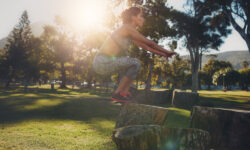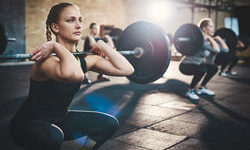Crucial for lifting, carrying, even cleaning our teeth and dressing – the shoulder and upper back are important but often neglected parts of our body.
Meanwhile, lucky legs! Of all the parts of our body, it is the legs, hips and bums that seem to get all the attention. When we talk about running, cycling, walking or many of the different exercise classes available to us, the emphasis is usually upon working the calves, hamstrings and quadriceps. Our focus is so often upon toning muscles in the lower part of the body and using exercises that centre around leg movement – cycling, walking, running – that we pay little attention to what is happening from the hips upwards.
Shouldering the load
Which means the shoulders and upper back can get a bad rap. If we think about the shoulders and back at all, it is normally in a recuperative or negative sense. ‘Oooh, my back hurts today,’ or ‘I avoid weights because I don’t want to get big shoulders.’ Many of the problems we experience in our upper body – neck, shoulder and upper back – stem from today’s working environment and our reliance upon computers. Sitting hunched over a computer screen for long periods of time, whether at a desk or on your lap, inevitably leads to poor posture and injury.
Fighting back
Well, it is time for the upper body to fight back. The back and shoulders are part of the most important of our body – its very core – and as such, we should be paying them a lot more attention. We are going to look at some ways you can use exercise to keep your shoulders and back in good condition.
But first the scientific bit. The back is the main support structure of your entire body. It comprises 24 moveable bones called vertebrae and has a spongy disc providing shock absorption between each of the vertebrae. Add to this, the numerous ligaments, tendons and muscles that connect your spinal column to the remainder of the body and you become aware of just how impressive, but ultimately fragile, the back is.
The shoulders are an extension of our core. Comprising a ball and socket joint, plus numerous connective tissue and muscles, healthy shoulders give us a full range of movement, allowing us to lift, reach and carry things. Without healthy shoulders, our arms will not work effectively. And, as anyone who has ever had their arm in a sling will know, shoulders are also important for balance.
Let’s pay the back and shoulders some attention.
The following exercises are designed to tone and mobilise the shoulders and back. By maintaining or increasing your mobility in the back and shoulders, you will find the benefits extend to your whole body. A healthy upper body will help you move with more balance and live a more active life.
Exercise #1 – Barbell overhead press
Grasp the bar just outside shoulder width. Lift it to shoulder level with your forearms perpendicular to the floor. Squeeze the bar and brace your abs. Press the bar overhead, pushing your head forward and shrugging your traps as the bar passes your face. Aim for 10 repetitions. To check you have the correct weight, the last three reps should be very tough.
Exercise #2 – Standing dumbbell fly
Hold a dumbbell in each hand by your sides. Without shrugging, use your upper body to swing the weights up a few inches. Your arms and torso will form an upside down V shape. Think of it as a lateral raise with momentum but without full range of motion. Do 10-12 repetitions.
Exercise #3 – High pull
Grasp the bar with hands about double shoulder width and hold it in front of your thighs. Bend your knees and hips so the bar hangs just above your knees. Explosively extend your hips as if jumping and pull the bar up to shoulder level with elbows wide apart, as in an upright row. Repeat this movement 10-12 times.
Exercise #4 – Seated dumbbell clean
Hold a dumbbell in each hand and sit on the edge of a bench. Keeping your lower back flat, lean forward. Explosively straighten your body and shrug the weights so your arms rise. Allow the momentum to flip your wrists so you catch the weights at shoulder level. Repeat 10-15 times.
Exercise #5 – Hindu pushup
This final exercise improves flexibility and promotes working with your own body weight. Get into pushup position. Push your hands on the floor to drive your weight back so your hips rise into the air. Your back should be straight and your head behind your hands. Lower your body in an arcing motion so that your chest scoops downward and nearly scrapes the floor. Continue moving forward as you press your body up so your torso is vertical and your legs are straight and nearly on the floor. That’s one rep.
With the exception of #5, you can do all of these exercises in front of a mirror, which allows you to check your posture. For exercises #1-4, you should be sitting straight, looking ahead, with your neck relaxed and your shoulders even. Remember to breathe easily throughout all the exercises – do not hold your breath.







